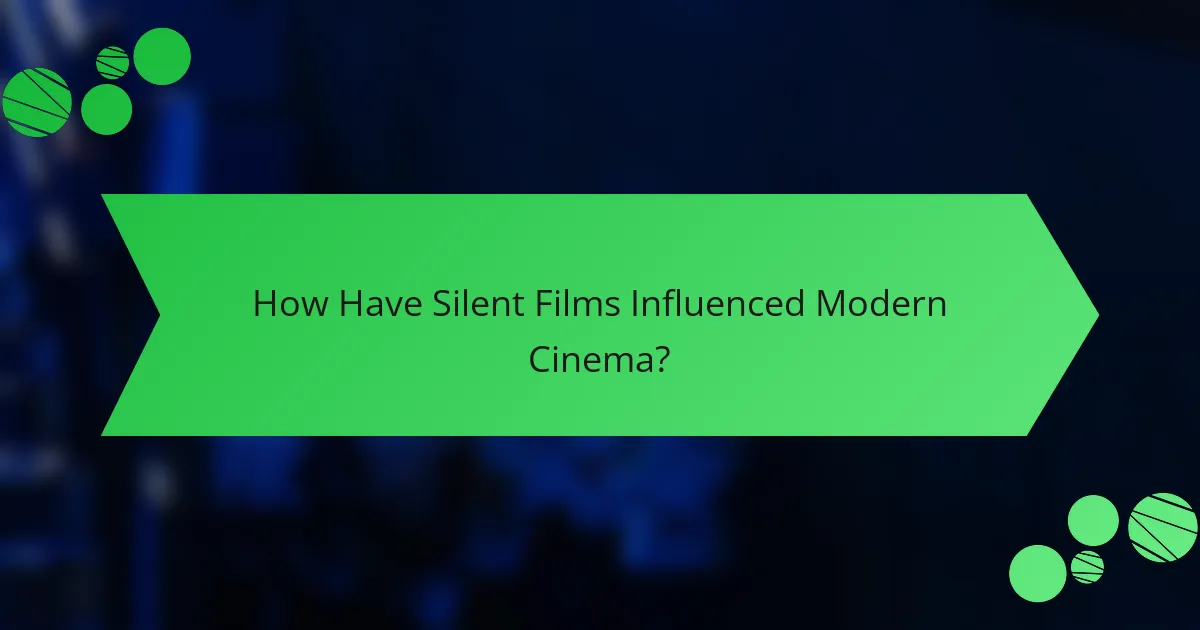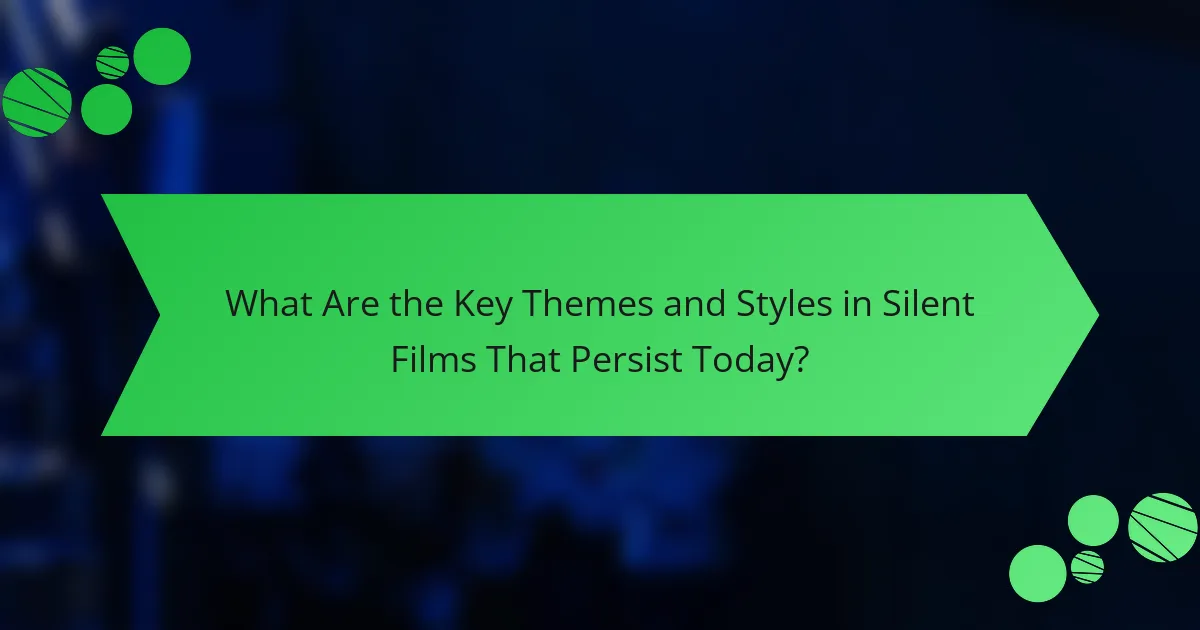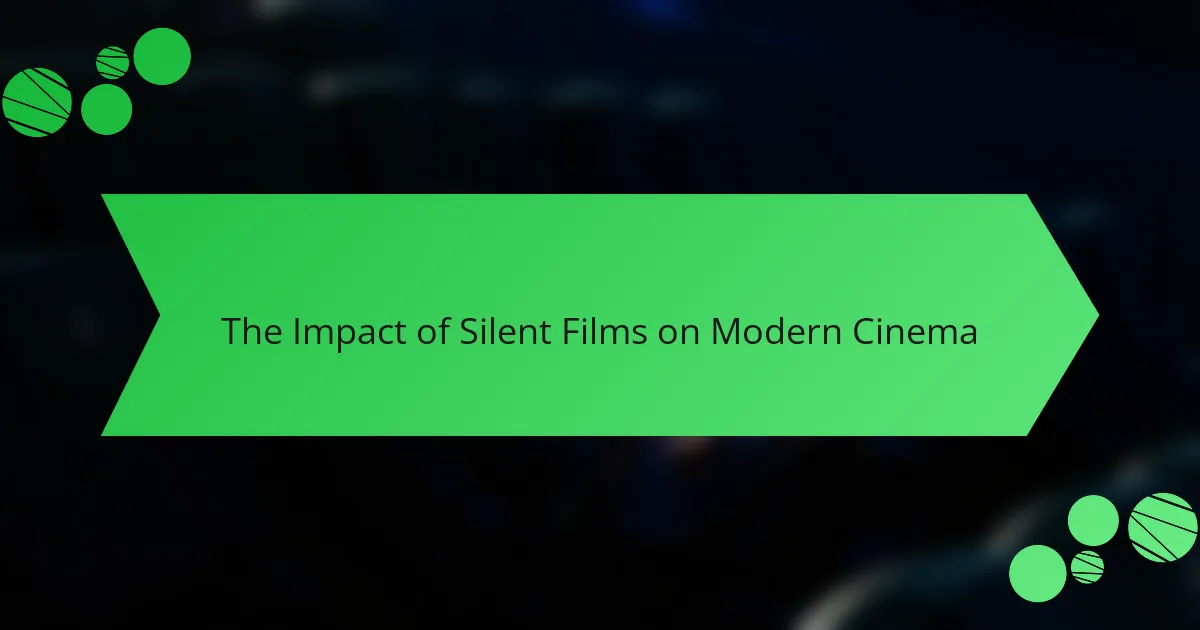
What are Silent Films and Their Historical Context?
Silent films are movies without synchronized sound or spoken dialogue. They rely on visual storytelling, intertitles, and music to convey the narrative. The silent film era began in the late 19th century, with significant growth during the 1910s and 1920s. Iconic silent films include “The Birth of a Nation” (1915) and “The Cabinet of Dr. Caligari” (1920). This period saw the rise of influential filmmakers such as D.W. Griffith and Charlie Chaplin. The transition to sound films, known as “talkies,” began in the late 1920s, marking the decline of silent films. Despite this, silent films laid the groundwork for cinematic techniques and storytelling methods still used today. Their historical context reflects the evolution of technology and audience expectations in cinema.
How did silent films evolve in the early 20th century?
Silent films evolved significantly in the early 20th century through technological advancements and changing audience expectations. Initially, films were short and simplistic, often lasting only a few minutes. The introduction of longer narratives became possible with innovations like the feature-length film. The first feature-length silent film, “The Story of the Kelly Gang,” was released in 1906, running over an hour.
Increased production values emerged as studios began investing in elaborate sets and costumes. The use of intertitles became common to convey dialogue and enhance storytelling. Notable directors, such as D.W. Griffith, pioneered techniques like close-ups and cross-cutting, which added depth to narratives.
The popularity of silent films peaked during the 1920s, with stars like Charlie Chaplin and Buster Keaton captivating audiences. The transition to sound began in 1927 with “The Jazz Singer,” marking the end of the silent film era. This evolution laid the groundwork for modern cinema by establishing narrative structures and cinematic techniques still used today.
What technological advancements facilitated the rise of silent films?
The rise of silent films was facilitated by several key technological advancements. The introduction of the motion picture camera allowed for the recording of moving images. Innovations in film stock improved image quality and sensitivity to light. The development of editing techniques enabled filmmakers to create coherent narratives. Projectors made it possible to display films to larger audiences in theaters. The use of intertitles provided essential dialogue and context. Improved lighting techniques enhanced visual storytelling. Additionally, the synchronization of live music with film screenings enriched the viewing experience. These advancements collectively contributed to the popularity and artistic development of silent cinema.
What were the cultural influences on silent film production?
Cultural influences on silent film production included societal norms, artistic movements, and technological advancements. The rise of the middle class in the early 20th century created a demand for entertainment. This led to the establishment of movie theaters and the popularity of film as a leisure activity. Artistic movements like Expressionism and Impressionism influenced visual storytelling techniques. The use of exaggerated gestures and intertitles was a response to the lack of sound. Additionally, cultural events such as World War I shaped narrative themes and character portrayals. The global exchange of ideas also impacted film styles, with European filmmakers introducing innovative techniques. These factors collectively shaped the silent film era, laying the groundwork for modern cinema.
Why are silent films significant in the history of cinema?
Silent films are significant in the history of cinema because they established foundational storytelling techniques and visual language. They relied on expressive acting, intertitles, and visual cues to convey emotions and narratives. This era introduced iconic filmmakers like D.W. Griffith, who pioneered editing techniques such as cross-cutting. Silent films also showcased the potential of the medium, leading to innovations in cinematography and set design. The transition to sound films in the late 1920s built upon the groundwork laid by silent cinema. Silent films remain influential, as many modern filmmakers draw inspiration from their visual storytelling methods. Their legacy is evident in contemporary cinema, highlighting the importance of visual expression in storytelling.
How did silent films shape narrative storytelling techniques?
Silent films significantly influenced narrative storytelling techniques by emphasizing visual storytelling over dialogue. They relied on expressive acting, gestures, and visual cues to convey emotions and plot. This created a unique language of cinema that prioritized imagery and symbolism. Iconic films like “The Birth of a Nation” and “The Cabinet of Dr. Caligari” showcased innovative techniques such as cross-cutting and montage. These methods allowed filmmakers to manipulate time and space effectively. The absence of sound pushed directors to focus on visual composition and framing. As a result, silent films laid the groundwork for modern cinematic techniques still used today. Their legacy continues to shape how stories are told visually in contemporary cinema.
In what ways did silent films influence acting styles?
Silent films significantly influenced acting styles by emphasizing physical expression and exaggerated gestures. Actors had to convey emotions without spoken dialogue. This led to a focus on body language and [censured] expressions. Many silent film stars, like Charlie Chaplin and Buster Keaton, mastered these techniques. The need for visual storytelling shaped the development of performance styles. This foundation laid the groundwork for modern acting. Elements of silent film acting can still be seen in contemporary cinema. The influence persists in genres that prioritize visual storytelling over dialogue.

How Have Silent Films Influenced Modern Cinema?
Silent films have significantly influenced modern cinema through their storytelling techniques and visual styles. They pioneered the use of visual storytelling, relying on images rather than dialogue to convey emotions and narratives. This approach laid the groundwork for modern filmmakers to explore visual symbolism and non-verbal communication.
Silent films also introduced innovative editing techniques, such as cross-cutting and montage, which are fundamental in contemporary film editing. Directors like D.W. Griffith demonstrated how editing could manipulate time and space, influencing how stories are structured today.
Additionally, silent films emphasized the importance of performance, as actors had to convey complex emotions without spoken words. This focus on physical expression continues to shape acting styles in modern cinema.
The use of intertitles in silent films also paved the way for modern subtitles and captions, enhancing accessibility for diverse audiences. Overall, silent films established essential cinematic language and techniques that remain integral to the art of filmmaking today.
What elements of silent films are still present in contemporary filmmaking?
Silent films utilized visual storytelling techniques that remain prevalent in contemporary filmmaking. These techniques include exaggerated [censured] expressions and body language to convey emotions without dialogue. Filmmakers today often employ visual metaphors and symbolism, akin to silent film practices, to enhance narrative depth.
Additionally, the use of title cards for dialogue or exposition in silent films has evolved into modern text overlays and subtitles. Cinematic techniques like montage editing, which gained prominence in silent cinema, continue to shape narrative pacing and structure in current films.
Moreover, the emphasis on visual composition and striking imagery from silent films influences contemporary cinematography. Elements such as lighting, framing, and shot composition are critical in both eras. The legacy of silent films is evident in the focus on visual aesthetics and storytelling that transcends language barriers in modern cinema.
How do visual storytelling techniques from silent films manifest in modern films?
Visual storytelling techniques from silent films manifest in modern films through the use of expressive imagery and minimal dialogue. Modern filmmakers often rely on visual cues to convey emotions and narratives, similar to silent film techniques. For instance, body language and [censured] expressions are emphasized to communicate character feelings. This approach mirrors the reliance on visual storytelling in films like “The Artist,” which pays homage to silent cinema. Additionally, modern films utilize montage and visual symbolism, techniques rooted in silent film traditions. The effective use of color grading and lighting also enhances the emotional tone, akin to the visual styles of early cinema. Overall, the influence of silent films is evident in how contemporary filmmakers prioritize visual elements to engage audiences.
What role does music play in both silent films and modern cinema?
Music serves as a crucial emotional and narrative tool in both silent films and modern cinema. In silent films, live music accompanied screenings, enhancing the storytelling experience. It provided emotional cues that guided audience reactions. Composers created scores that matched the film’s mood, from suspenseful to comedic. In modern cinema, music continues to shape viewer emotions. Film scores and soundtracks are integral to storytelling. They enhance character development and plot progression. Historical examples include the use of orchestral scores in classics like “Gone with the Wind.” Both silent and modern films demonstrate music’s power in creating atmosphere and evoking feelings.
Why is the legacy of silent films important for filmmakers today?
The legacy of silent films is important for filmmakers today because it established foundational storytelling techniques. Silent films relied heavily on visual storytelling, which emphasized the importance of imagery and body language. This approach continues to influence modern filmmaking, encouraging directors to think visually. Additionally, silent films showcased the power of editing and pacing. Techniques like cross-cutting and montage originated in this era, shaping contemporary narrative structures. The emotional depth conveyed without dialogue also inspires filmmakers to create impactful scenes. Iconic silent film directors, such as Charlie Chaplin and Buster Keaton, set high standards for creativity and innovation. Their work remains a reference point for filmmakers striving to push artistic boundaries today.
How do filmmakers reference silent film techniques in their work?
Filmmakers reference silent film techniques by employing visual storytelling methods. They often utilize exaggerated expressions and body language to convey emotions. This mimics the performance style of silent film actors. Additionally, filmmakers may incorporate title cards to provide context or dialogue. They also use techniques like montage and visual symbolism, which were prevalent in silent cinema. For instance, directors like Quentin Tarantino and Martin Scorsese have cited silent films as influences in their work. These references demonstrate the lasting impact of silent film techniques on narrative structure and visual style in modern cinema.
What lessons can modern filmmakers learn from silent films?
Modern filmmakers can learn the importance of visual storytelling from silent films. Silent films relied heavily on imagery to convey emotions and narratives without dialogue. This approach emphasizes the power of visual cues, gestures, and expressions. Filmmakers can create more impactful scenes by focusing on these elements. Additionally, silent films often utilized innovative editing techniques to enhance storytelling. Techniques like cross-cutting and montages can be valuable tools for modern filmmakers. The pacing in silent films also teaches the significance of rhythm in storytelling. Understanding how to build tension through pacing can lead to more engaging narratives. Lastly, silent films showcased the effectiveness of universal themes. These themes resonate across cultures and time periods, offering timeless lessons for contemporary storytelling.

What Are the Key Themes and Styles in Silent Films That Persist Today?
Key themes and styles in silent films that persist today include visual storytelling, exaggerated expressions, and intertitles. Visual storytelling relies on imagery to convey emotion and narrative without dialogue. This technique remains essential in modern cinema, especially in genres like animation and action films. Exaggerated expressions were crucial for actors to communicate feelings effectively. Today, actors still use body language and [censured] expressions to convey emotion, particularly in non-verbal scenes. Intertitles provided essential context in silent films. Modern films often use text overlays and subtitles to enhance storytelling. The influence of these elements demonstrates the lasting impact of silent films on contemporary filmmaking.
Which genres of silent films have influenced modern cinematic genres?
Silent film genres that have influenced modern cinematic genres include comedy, horror, and drama. The slapstick comedies of silent films laid the groundwork for modern comedy. Iconic figures like Charlie Chaplin and Buster Keaton showcased physical humor that is still prevalent today. Horror films from the silent era, such as “The Cabinet of Dr. Caligari,” established visual storytelling techniques that modern horror employs. The expressionist style of these films influenced the aesthetics of contemporary horror. Silent dramas, exemplified by films like “Broken Blossoms,” emphasized emotional storytelling, which remains central to modern drama. These genres have shaped narrative structures and visual styles in today’s cinema.
How do themes of romance and comedy from silent films appear in current films?
Themes of romance and comedy from silent films are prevalent in current films. Many contemporary romantic comedies draw inspiration from the visual storytelling techniques of silent cinema. These films often utilize exaggerated [censured] expressions and physical humor to convey emotions, similar to silent film stars like Charlie Chaplin and Buster Keaton.
Current films also employ romantic tropes that echo those found in silent cinema, such as the classic love triangle or the comedic misunderstanding. The narrative structure often mirrors silent films, relying on visual gags and situational comedy.
For instance, movies like “La La Land” incorporate musical elements reminiscent of silent film charm, blending romance and comedy effectively. This connection highlights the enduring influence of silent films on contemporary storytelling.
What stylistic elements from silent films are utilized in modern horror films?
Modern horror films utilize several stylistic elements from silent films. These elements include exaggerated [censured] expressions, which convey emotions without dialogue. Additionally, the use of title cards in silent films has influenced modern horror’s reliance on visual storytelling. Lighting techniques, such as chiaroscuro, create tension and atmosphere in both genres. The pacing of suspenseful scenes often mirrors the slow build found in silent cinema. Furthermore, the use of practical effects over CGI echoes the tangible realism of silent film techniques. Iconic examples include the influence of films like “Nosferatu” on contemporary horror aesthetics. These stylistic choices enhance the emotional impact and visual storytelling in modern horror films.
How do silent films impact audience engagement in today’s cinema?
Silent films enhance audience engagement in today’s cinema by fostering a unique viewing experience. They encourage viewers to focus on visual storytelling and non-verbal cues. This engagement is heightened through the use of expressive performances and imaginative cinematography. Silent films often evoke a strong emotional response due to their reliance on music and visuals. For instance, iconic silent films like “The Artist” have demonstrated that audiences can connect deeply without dialogue. Studies indicate that silent film screenings can increase audience empathy and interpretation skills. This impact is evident in modern filmmakers who incorporate silent film techniques to captivate viewers. Overall, silent films play a significant role in shaping contemporary audience engagement strategies.
What techniques from silent films enhance emotional responses in viewers?
Silent films enhance emotional responses in viewers through techniques such as expressive acting, visual storytelling, and intertitles. Expressive acting relies on exaggerated [censured] expressions and gestures to convey emotions without dialogue. This technique allows viewers to connect with characters on a deeper level. Visual storytelling utilizes cinematography, lighting, and framing to evoke specific moods. For instance, low-key lighting can create a sense of tension or sadness. Intertitles provide context and emotional cues, guiding viewers’ interpretations of scenes. Historical examples include films like “The Birth of a Nation” and “The Cabinet of Dr. Caligari,” which effectively employed these techniques. Research shows that viewers often experience heightened emotions when visuals are paired with strong, silent performances.
How do filmmakers use silence and sound to create tension in their narratives?
Filmmakers use silence and sound strategically to create tension in narratives. Silence can amplify suspense by creating an unsettling atmosphere. It allows audiences to focus on visual cues and character expressions. Meanwhile, sound can heighten emotional responses through music and sound effects. Sudden loud noises can startle viewers, increasing anxiety. Conversely, low-volume sounds can build anticipation. Filmmakers often manipulate soundscapes to reflect characters’ inner turmoil. Historical examples include Alfred Hitchcock’s use of silence in “Psycho” to enhance fear. Overall, the interplay of silence and sound is essential for crafting gripping cinematic experiences.
What are practical ways filmmakers can incorporate silent film techniques into their work?
Filmmakers can incorporate silent film techniques into their work by emphasizing visual storytelling. This involves using expressive body language and [censured] expressions to convey emotions without dialogue. Additionally, filmmakers can utilize title cards to deliver essential information or dialogue, a common practice in silent films.
Another method is to focus on mise-en-scène, where the arrangement of scenery and props enhances the narrative. Filmmakers can also experiment with exaggerated acting styles, reminiscent of silent film stars, to create a distinct tone.
Moreover, employing a score that complements the visuals can evoke emotions similar to the original silent film experience. Techniques like cross-cutting and montage can also be used to build tension and pace, reflecting silent film editing styles.
Historical context shows that many modern filmmakers, such as Martin Scorsese, have drawn inspiration from silent cinema to enrich their storytelling. These methods enhance the visual experience and pay homage to the roots of filmmaking.
The main entity of the article is silent films and their influence on modern cinema. The article provides a comprehensive overview of silent films, detailing their historical context, evolution, and the technological advancements that facilitated their rise. It highlights the significance of silent films in shaping narrative storytelling techniques, acting styles, and visual aesthetics, while also exploring how these elements persist in contemporary filmmaking. Key themes such as visual storytelling, emotional expression, and the legacy of iconic filmmakers are examined, demonstrating the lasting impact of silent cinema on today’s film industry.
